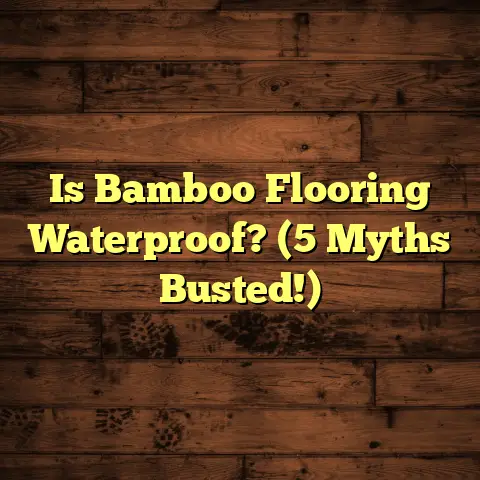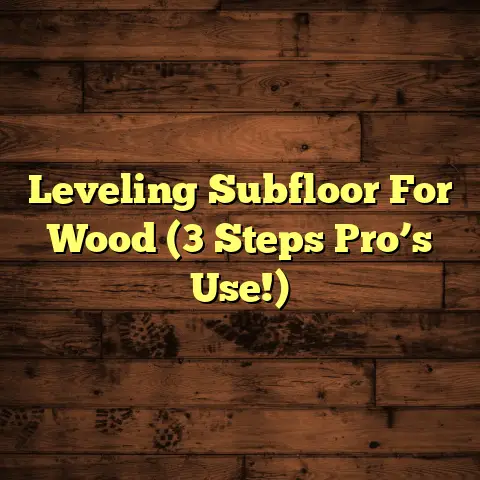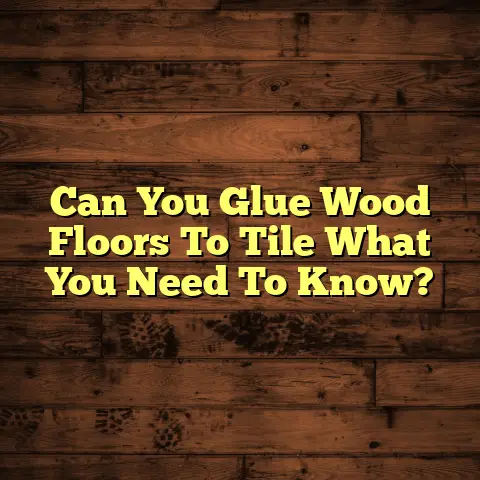Babies Crawling On Hard Floors? (7 Hidden Dangers!)
And as a parent myself, I totally get the excitement (and maybe a little bit of anxiety) when your little one starts to explore the world on all fours.
Crawling is HUGE! It’s a massive leap in their physical and cognitive development.
It unlocks a whole new world of discovery for them. But let’s be honest, that newfound mobility can be a bit nerve-wracking, especially when it comes to the safety of your home.
We spend so much time baby-proofing. But sometimes, the most obvious things, like our floors, can present hidden dangers we don’t even realize.
And that’s what I want to talk about today: hard floors and those precious crawling babies.
While hard floors like tile, hardwood, or laminate might seem like a practical and stylish choice for your home, they can actually pose some serious risks for your little explorer.
So, let’s dive into the seven hidden dangers of babies crawling on hard floors. Trust me, you’ll want to know about these!
Section 1: The Hard Reality of Hard Floors
Okay, let’s get down to brass tacks. What are hard floors, anyway?
We’re talking about materials like:
-
Tile: Think ceramic, porcelain, and stone. Super durable, water-resistant, and great for high-traffic areas.
-
Hardwood: Classic, beautiful, and adds value to your home. But requires a bit more maintenance.
-
Laminate: A more affordable alternative to hardwood. It mimics the look of wood or tile.
-
Vinyl: Versatile, waterproof, and comes in a huge range of styles. Great for kitchens and bathrooms.
Now, how do these surfaces differ from soft flooring options like carpets and rugs?
Well, the obvious difference is the feel. Hard floors are, well, hard. They offer little to no cushioning.
Carpets and rugs, on the other hand, provide a softer, more forgiving surface.
Think about it this way: if you fall on carpet, it’s going to hurt a lot less than if you fall on tile, right?
Here’s a quick comparison table:
| Feature | Hard Floors | Soft Floors (Carpet/Rugs) |
|---|---|---|
| Cushioning | Minimal to None | Significant |
| Maintenance | Easy to Clean | Requires Regular Vacuuming/Cleaning |
| Durability | High | Moderate |
| Allergen Trap | Less Likely to Trap Allergens | More Likely to Trap Allergens |
| Slip Resistance | Lower | Higher |
So, what are the benefits of hard floors? Well, they’re generally easier to clean than carpets. They’re more durable, and they can be a great choice for people with allergies since they don’t trap dust and dander as easily.
But here’s the rub: that lack of cushioning can be a major problem for a baby who’s just learning to crawl.
Which leads us to our first hidden danger…
Section 2: Danger #1 – Slips and Falls
Alright, let’s talk about slips and falls. This is probably the most obvious danger, right?
Babies are still developing their coordination and balance. They’re wobbly! They’re learning to use their muscles. And hard floors offer very little traction.
Think about it: have you ever tried to walk across a polished tile floor in socks? It’s like an ice rink!
Now imagine a baby, still figuring out how to move their arms and legs, trying to navigate that same surface.
According to the CDC (Centers for Disease Control and Prevention), falls are a leading cause of non-fatal injuries for children under one year old. (Source: CDC Injury Prevention & Control) While the data might not be specific to crawling on hard floors, it certainly highlights the vulnerability of infants to falls.
I’ve seen firsthand the consequences of these slips and falls. I remember one family who had beautiful, high-gloss porcelain tiles throughout their home.
Their little one was just starting to crawl, and he kept slipping and sliding. They tried everything – socks with grips, little knee pads – but nothing seemed to work perfectly.
One day, he slipped and hit his head on the tile. Thankfully, it wasn’t a serious injury, but it was a huge wake-up call for them.
They ended up investing in some large, soft playmats to cover the areas where he crawled the most.
The truth is, babies often lack the muscle strength and coordination to catch themselves when they start to fall on a slippery surface.
And that can lead to some pretty nasty bumps and bruises.
Section 3: Danger #2 – Impact Injuries
Okay, so we know that slips and falls are a risk. But what happens when they fall? That’s where impact injuries come in.
When a baby falls on a hard surface, there’s very little to absorb the impact. Their little bodies are basically slamming against a solid surface.
This can lead to a range of injuries, from minor bruises and scrapes to more serious issues like fractures and head injuries.
The severity of the injury depends on a few factors:
-
The height of the fall: Obviously, a fall from a standing position is more dangerous than a fall from a sitting position.
-
The surface they fall on: Tile and concrete are harder than hardwood or laminate.
-
The way they land: Landing on their head is the most dangerous scenario.
According to the American Academy of Pediatrics (AAP), head injuries are a major concern for infants and young children. (Source: American Academy of Pediatrics – HealthyChildren.org)
Their skulls are still developing and are more susceptible to fractures.
I’ve seen cases where babies have suffered minor skull fractures from relatively low-impact falls on hard floors. It’s scary stuff.
And it’s not just fractures we need to worry about. Concussions, even mild ones, can have long-term effects on a child’s development.
That’s why it’s so important to monitor babies closely during this crawling stage and to take steps to minimize the risk of falls and impact injuries.
Section 4: Danger #3 – Temperature Sensitivity
This one might not be as obvious as slips and falls, but it’s still important. Hard floors can get cold, especially in the winter months.
And babies are much more sensitive to temperature changes than adults are.
Their bodies are still developing their ability to regulate temperature. They lose heat much faster than we do.
When a baby spends a lot of time crawling or playing on a cold floor, they can quickly become chilled, which can lead to hypothermia in severe cases.
Hypothermia occurs when the body loses heat faster than it can produce it, leading to a dangerously low body temperature.
Symptoms of hypothermia in infants can include:
-
Shivering (though some babies may not shiver)
-
Cold, pale skin
-
Lethargy or drowsiness
-
Weakness
I remember one winter, I got a call from a worried mom whose baby was constantly cold.
She had beautiful slate floors throughout her house, and even with the heating on, the floors were freezing to the touch.
She was worried about her baby getting sick.
I suggested she invest in some heated rugs or floor mats to warm up the areas where her baby spent the most time. It made a huge difference.
Now, you might be thinking, “Okay, I’ll just crank up the heat!” But that’s not always the best solution.
Overheating can also be dangerous for babies. The key is to find a balance.
Here are some tips for minimizing the risk of temperature sensitivity:
-
Use rugs or playmats: These provide a layer of insulation between the baby and the cold floor.
-
Dress your baby in layers: This allows you to adjust their clothing as needed.
-
Check the floor temperature: Use your hand or foot to feel how cold the floor is.
-
Consider radiant floor heating: This can be an expensive option, but it’s a great way to keep your floors warm and comfortable.
Section 5: Danger #4 – Allergens and Dust
Okay, let’s talk about allergens and dust. This is another hidden danger that many parents don’t think about.
Hard floors, while easier to clean than carpets, can still accumulate dust, pollen, pet dander, and other allergens.
And when a baby is crawling around on the floor, they’re constantly exposed to these irritants.
This can trigger allergic reactions, asthma symptoms, and other respiratory issues.
According to the Asthma and Allergy Foundation of America (AAFA), allergies and asthma are common in young children. (Source: Asthma and Allergy Foundation of America – aafa.org)
Exposure to allergens and dust can exacerbate these conditions.
Think about it: babies spend a lot of time with their faces close to the floor. They’re breathing in all that dust and allergens.
And they’re also putting their hands in their mouths after touching the floor.
I’ve seen cases where babies have developed persistent coughs, runny noses, and even skin rashes from crawling on dusty floors.
The key to minimizing this risk is regular cleaning and maintenance.
Here are some tips:
-
Vacuum frequently: Use a vacuum cleaner with a HEPA filter to trap dust and allergens.
-
Mop regularly: Use a damp mop to remove surface dirt and grime.
-
Dust frequently: Dust furniture, shelves, and other surfaces to prevent dust from settling on the floor.
-
Use an air purifier: An air purifier with a HEPA filter can help to remove allergens and dust from the air.
-
Consider hypoallergenic flooring: Some types of flooring, like bamboo or cork, are naturally hypoallergenic.
Section 6: Danger #5 – Sharp Edges and Corners
Alright, let’s talk about sharp edges and corners. This is another potential hazard that’s often overlooked.
When a baby is crawling around, they’re at a low level, which means they’re more likely to bump into furniture and fixtures.
And if those furniture pieces have sharp edges or corners, it can lead to cuts, bruises, and even more serious injuries.
Think about coffee tables, TV stands, and even the edges of your kitchen counters. These can all pose a risk to a crawling baby.
I remember one client who had a beautiful glass coffee table with sharp, pointed corners.
Their baby was just starting to crawl, and they were constantly worried about him bumping into it.
They ended up wrapping the corners of the table in thick foam padding.
It wasn’t the most stylish solution, but it gave them peace of mind.
Here are some tips for mitigating the dangers of sharp edges and corners:
-
Use edge and corner guards: These are soft, padded protectors that you can attach to furniture.
-
Choose furniture with rounded edges: When buying new furniture, look for pieces with rounded edges and corners.
-
Move furniture away from crawling areas: If possible, move furniture with sharp edges away from the areas where your baby crawls the most.
-
Supervise closely: Always supervise your baby when they’re crawling, especially in areas with potentially hazardous furniture.
Section 7: Danger #6 – Chemical Exposure
This is a big one, folks. Chemical exposure. It’s something that’s really close to my heart.
We often don’t think about the chemicals that are present in our homes, but they can pose a significant risk to crawling babies.
Hard floors can be treated with various finishes, sealants, and cleaning products that contain potentially harmful chemicals.
And babies, being babies, love to put their hands and mouths on everything, including the floor.
This means they can ingest or absorb these chemicals, which can lead to a variety of health problems.
Some of the chemicals to watch out for include:
-
Formaldehyde: A known carcinogen that can be found in some laminate flooring and adhesives.
-
Volatile Organic Compounds (VOCs): Released from many types of flooring, adhesives, and cleaning products. Can cause respiratory irritation, headaches, and other health problems.
-
Phthalates: Found in some vinyl flooring and can disrupt hormone function.
-
Pesticides: Used in some cleaning products and can be harmful to the nervous system.
According to the Environmental Protection Agency (EPA), children are more vulnerable to the effects of chemical exposure than adults. (Source: Environmental Protection Agency – epa.gov)
Their bodies are still developing, and they have a higher metabolic rate, which means they absorb chemicals more quickly.
I always advise my clients to choose flooring and cleaning products that are non-toxic and baby-safe. Look for products that are labeled as “low-VOC” or “formaldehyde-free.”
Here are some tips for minimizing chemical exposure:
-
Choose non-toxic flooring: Look for flooring options that are certified by organizations like GreenGuard or FloorScore.
-
Use natural cleaning products: Avoid harsh chemicals and opt for natural cleaning products made with ingredients like vinegar, baking soda, and lemon juice.
-
Ventilate your home: Open windows and doors to allow fresh air to circulate.
-
Wash your baby’s hands frequently: This will help to remove any chemicals they may have picked up from the floor.
Section 8: Danger #7 – Limited Mobility and Exploration
Now, this last danger is a bit different. It’s not about physical harm, but rather about how hard floors can limit a baby’s ability to explore and develop.
Hard floors can be slippery and unforgiving, which can make it difficult for babies to move around and explore their environment.
This can lead to frustration and discourage them from crawling, which can potentially affect their developmental progress.
Think about it: if every time a baby tries to crawl, they slip and fall, they’re going to be less likely to try again.
They might become hesitant and fearful of moving around.
I’ve seen cases where babies who have spent a lot of time on hard floors have been slower to develop their crawling skills compared to babies who have spent more time on softer surfaces.
The key is to create a safe and conducive environment for crawling.
This means providing a surface that is both supportive and forgiving.
Here are some tips:
-
Use playmats or rugs: These provide a softer, more grippy surface for babies to crawl on.
-
Encourage tummy time: Tummy time helps to strengthen a baby’s muscles and develop their motor skills.
-
Provide a variety of textures: Expose your baby to different textures, like carpet, grass, and sand, to help them develop their sensory skills.
-
Be patient and supportive: Encourage your baby to explore and move around, but don’t push them too hard.
Conclusion
So, there you have it – the seven hidden dangers of babies crawling on hard floors.
From slips and falls to chemical exposure, there are a number of potential hazards that parents need to be aware of.
But don’t panic! By being vigilant and proactive, you can create a safe and conducive environment for your little explorer.
Remember:
-
Cushion the impact: Use rugs, playmats, and edge guards to protect your baby from falls.
-
Control the temperature: Keep your floors warm and comfortable to prevent hypothermia.
-
Clean regularly: Vacuum and mop frequently to remove dust and allergens.
-
Choose safe products: Opt for non-toxic flooring and cleaning products.
-
Encourage exploration: Provide a variety of textures and surfaces to help your baby develop their motor skills.
Ultimately, the goal is to create a home that is both beautiful and safe for your family.
By taking these precautions, you can rest assured that your baby is free to explore and discover the world around them without putting themselves at risk.
Happy crawling, everyone!





